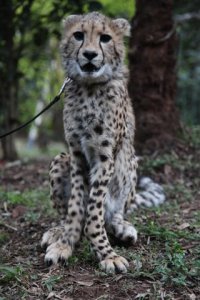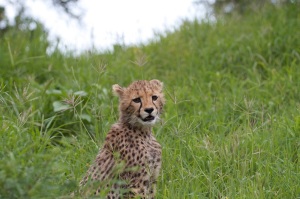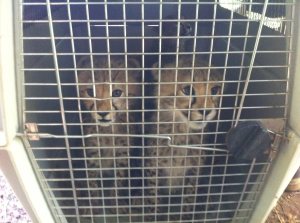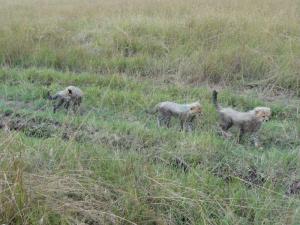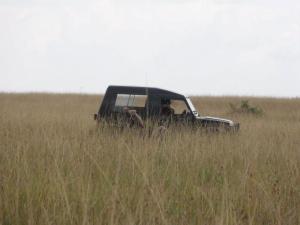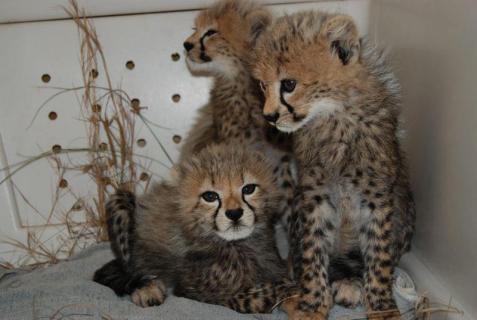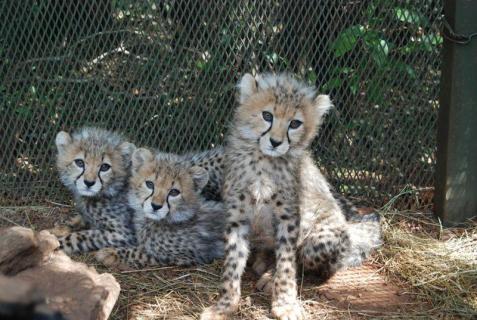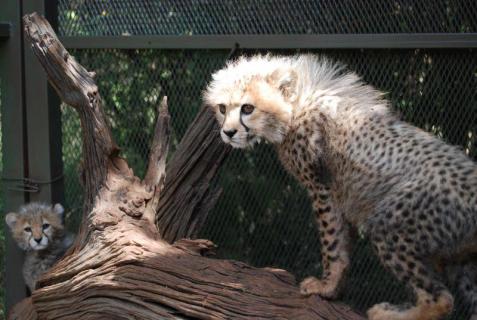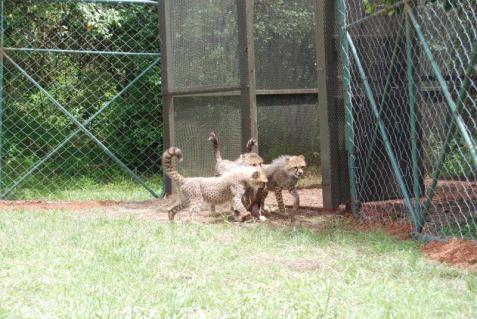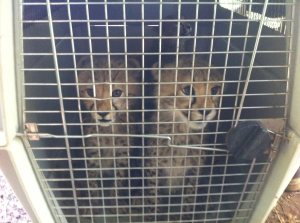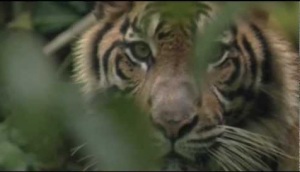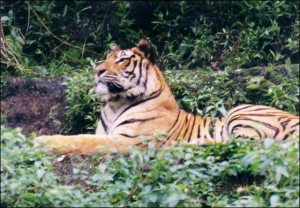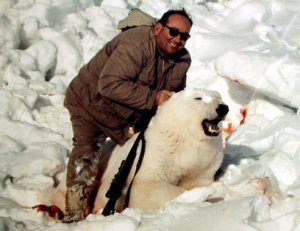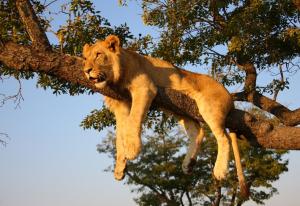1. Where did the original lions come from? Were they captive raised?
When Andrew Conolly bought Antelope Park originally the property came with some captive lions already as part of the sale. This number was supplemented with other lions from owners/breeders within Zimbabwe to form the founder group of the program. Any further specific details will need to be requested directly from Antelope Park. They were all captive bred to my knowledge. We are giving sanctuary to one lion that according to the previous owner, was found, with another lion, as orphaned cubs in Hwange National Park and taken in. For obvious reasons I cannot comment on the accuracy of their former owners claim. We were asked to take them both, and
their cubs (which are inbred), into the program to save them from being euthanized. These two lions (only one of which is still alive) are the only lions in the program that were wild born.

Pride females at the waterhole
2. Why are the cubs taken from the mum?, and at what age are they taken?. Are they kept separated from mum? ie: out of her sight
The mother of the cubs is captive and therefore does not have the skills that the cubs need to learn to survive when given the opportunity to fend for themselves. It is also not possible to give those adult lions the opportunity to learn the necessary skills. The cubs are taken away and hand raised as by doing so we are able to provide a means for those cubs to develop their natural instincts. The cubs are taken away at 3 weeks old which allows them to take advantage of the more nutritious milk that mother’s provide in the first days post-partum, with benefits for the cubs immune systems and overall health. Antelope Park have also found that three weeks is ideal in terms of the cubs development; taking them younger and the cubs maybe bond too much to humans with greater safety issues for their handlers and seem to develop less quickly, but taking them later and the cubs struggle to bond sufficiently that they trust their handler enough to go on walks during which they develop their natural instincts. When the cubs are removed the mother is placed in another enclosure, with food, and with her usual kin-group with which she then remains. She does not see the cubs again.
Whilst you have not asked about cubbing intervals, I shall provide some information here as a common assumption is that Antelope Park force breeds females as it is commonly asserted that the canned hunting industry breed with females as soon after cubs are removed as such action causes the female to come into oestrus quickly. It should be noted that conception during the first four months of the loss of cubs is unlikely so the voracity of this assertion is not necessarily correct. But yes, it is likely the canned hunting industry breed more frequently than wild lions would and I am sure they try to breed immediately. In the wild, when a litter is raised to maturity the mean litter interval is 601.5 (range 481.7 – 721.3) days at Phinda [1]; In Serengeti NP the mean was 600 days (range 330 – 750) [2] when a litter was raised to maturity and a range of 120 – 180 months if it lost. I have obtained the details of Antelope Park’s breeding rate for females that have had more than one litter; 527 days for cubs that survived at least three weeks and 314 days if the previous litter was lost during the first three weeks. The breeding interval is therefore slightly below the mean for wild lions, but well within the range of both quoted studies.
[1] Hunter LTB (1998) The behavioural ecology of reintroduced lions and cheetahs in the Phinda Resource Reserve. Kwa-Zulu-Natal, South Africa Ph.D thesis, University of Pretoria.
[2] Packer C, Pusey AE (1987) Intrasexual cooperation and the sex ratio in African lions. Am. Nat 130: 636 – 642

Two of the females and the pride male spot some zebra
3. Walk me through the training that you give to the lion cubs.
The cubs are not trained, they are just provided with opportunities to develop naturally. From the earliest age, just as their mother would do,
cubs are disciplined if they try to interact with a human in a way that could later be deemed unsafe; this would include the use of claws or teeth,
jumping up or trying to play with a human (which for a lion would usually include the use of teeth and claws). The most effective and humane method is to administer a flick (for young cubs) or a slap with an open palm (for older cubs) to the side of the muzzle whilst using the word “no” in an authoritative tone. Through this method the youngest cubs learn the limits of acceptable behaviour with humans and soon understand the word “no” such that they will cease any intention to play with a human if the command is used. When older this command is usually accompanied by pointing at the lion and looking at it. As opportunistic animals play is often initiated when the object of play is unaware of the oncoming interaction, and usually not followed through when the instigator feels it has been spotted. This is to be honest difficult to appreciate unless you have seen it and equally difficult to comprehend that it would work, but I can assure you that the cubs are not harmed through this method and it does work; it is the only method used. For example, a flick, or a slap on another part of its face could cause injury and is therefore not done, and the lions are never hit with anything else. Having said that, there are some well documented examples of when a lion has over-stepped the boundary and a small number of people have been injured. I actually fairly recently calculated the odds of injury by interacting with our lions compared to other causes of injury in response to claims that our program that allows visitors to interact with the lions under certain conditions was unnecessarily dangerous. It turns out, according to US statistics that you are more likely to die from intentionally injuring yourself than you are from being injured (over and above an occasional surface scratch) through interacting with these lions in the manner undertaken by Antelope Park and Lion Encounter. You are significantly more likely to die in a car crash. You are more likely to die from using a toilet.
After that, as I say, it is presenting the cubs with opportunities for natural behaviours to develop. This starts with building trust; only when
young animals feel happy and secure do they engage in play, a vital part of development, and only when they feel secure in their handlers presence will they have the confidence to follow them out into their natural environment. When on walks they are led to various areas where they can interact with their environment and the other fauna and flora that lives there. Again the best way to appreciate this is to see it. And the best way I can give you the opportunity to do that is to watch the TV series Lion Country, most episodes of both series being available here:
http://lionalert.org/pages/lion_country.html
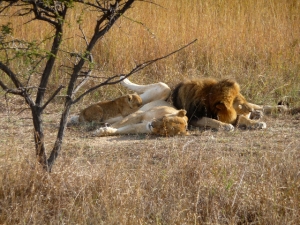
Cub suckles Mum with Dad next to them
4. A lot of people think that breeding lion cubs in captivity is wrong. Can you tell me the benefits of captive breeding in your program?
Hopefully what I have already written and what can be seen in the TV series answers this question in terms of the opportunities for the cubs to develop the necessary skills. It has been said that the staged release program is convoluted, but this comes from the same people that also suggest that captive bred lions cannot be released directly into the wild, and so the only way to achieve suitable captive bred lions for release is through a staged program where only the semi-wild borne cubs are released. And so, if you will permit me, I rephrase the question to ask about why is there a need for a captive program when there are wild lions that could be translocated. I have attached an article that will provide information on this; see “White Paper – Reintroduction sources of lions” For more information please read http://lionalert.org/documents/ALERT%20Introduction.pdf & http://lionalert.org/documents/ALERT%20Lion%20Conservation.pdf
Lion populations across Africa have declined considerably, estimates showing a decrease of about 30% in the last twenty years. With few exceptions, lion populations now occur as isolated remnants with doubtful long-term viability. Natural re-colonization of areas in which populations have decreased or have been eliminated is unlikely given continued fragmentation of remaining suitable habitat. This raises the importance of interventionist approaches in lion conservation through translocation and reintroduction programs. The costs and logistical complexity of any reintroduction program are high, and as such, the purpose of this paper is to examine the suitability of wild-caught lions as source populations. We estimate that only six geographically clustered populations contain sufficient individuals to potentially serve as a source for reintroduction programs but analysis of the risks of inbreeding depression and disease prevalence within free-ranging populations precludes their use in reintroduction programs even if genetic, political and economic barriers to their use could be overcome. The use of captive bred lions potentially allows barriers that make wild-caught lions non-viable as a source to be removed; however, reintroduction of captive bred stock brings additional complexity in reintroduction methodology.
Much of the issues people have as regards captive lions is the images they see of people holding cubs and bottle feeding them in their arms, and the parade of people throughout a day through whose arms these cubs have to endure attention without sufficient time to rest and partake in species specific behaviours necessary for their proper development. This in my opinion constitutes animal abuse and should not be permitted and it is not permitted at Antelope Park or Lion Encounter.
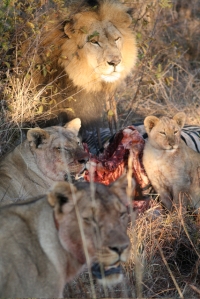
At a successful kill
5. Obviously your facility has limited space for the Lions. To prevent overcrowding, how do you manage the breeding rates?
Lions are kept in single gender groups well before they reach sexual maturity to ensure no uncontrolled breeding takes place. Different gender
groups are maintained next to each other so, even through a fence, they can continue to socially interact with both genders so as not to decrease social ability.
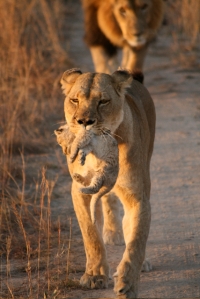
Mother & Cub with pride male (Dad) in the background
6. You have 3 stages that the lions go through, can you explain that to me a bit more in detail?.
The first stage is the cubs going on walks and later night encounters – when they are 18 months old and starting to become independent. This is when their handlers are on a vehicle and the lions are let out of their enclosure. The lions are followed to observe their walk. This is a good
time to have them out and about, in a way that keeps people safe, as lions are more active at night and allows them to practice their hunting skills further at a time that is most natural to them. A red spotlight is used to monitor the lions. Then there is the release stage where the lions have to exist in a semi-wild environment (semi-wild meaning fenced and managed) and become socially stable and self-sustaining; free of human contact. ALERT researchers observe, from a caged vehicle to break up our form. In these areas the pride has cubs which can be released into the wild (big debate on what that means starting now….but we mean a natural area, sometimes fenced, sometimes not, managed to a lesser degree and free-ranging with the opportunity to form a territory of expected size, with interactions with the usual range of African wildlife species). This release will follow standard translocation and reintroduction techniques for lions that have been used successfully for many years.
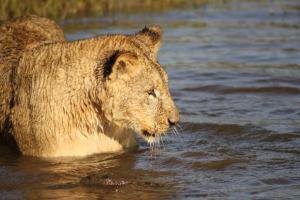
Wading through the water
7. Some of the lions have been sold onto other venues. Which venues have taken them?. Do you keep a track of them? (ie: check on them) & have any of your lions, that you know of, ended up in canned hunting venues?
There were two sales of lions from Antelope Park to South Africa which are well documented and have been the focus of an article in the UK’s Times newspaper claiming that they were sold to hunters. Antelope Park complained to the UK’s Press Complaints Commission which commenced an investigation into the sales. Documentation was provided by Antelope Park including the export permits issued by the Zimbabwe Parks & Wildlife Management Authority that states clearly that the lions could not be used for hunting. Letters were also provided by the two buyers stating that the lions would not be used for hunting. The onus to ensure that this stipulation was upheld was placed with the South African wildlife authorities as it is their legal jurisdiction. As a result of this investigation the PCC ordered the newspaper to retract the article and issue an apology which was printed later in the same newspaper. Other claims of animal abuse were also made and again, evidence of these untruths were provided including letters from various independent parties to attest to the fact that the animals were well cared for. This is all well before my time starting work for the organization and I am not aware of action to track these lions after the sale. It is possible that the lions were subsequently resold against the conditions of the sale and ended up in the canned hunting industry. It is also possible that they did not. It is possible that these lions were used to breed with and those offspring were used in the canned hunting industry. And again it is possible that this is not the case. I personally believe that it is quite likely given South Africa’s lax legal systems as regards wildlife, that at least some of these lions ended up being hunted, but I have no evidence to support this belief. I am also confident that legal measures were adequately put in place that this should not have happened.
You can read more about this issue in the 3rd question down on this page
(http://lionalert.org/pages/faq.html)
Lions have been donated to ALERT for release into the next stage of the program; the Ngamo & Dambwa release prides. One inbred lion (Nduna) for which Antelope Park was providing sanctuary was transferred to Ballyvaughan Sanctuary in Harare at their request and one adult breeding male (Teddy) was transferred to Imire, near Harare, at their request, both in 2009. Two lions were transferred to Zambezi Nature Sanctuary at their request. One was a seven year old male (Mickey) with deformities of his reproductive system, the other was a stunted female (Alice) aged nine years old; neither lion could be released.
Any more specific details needed should be requested from Antelope Park directly. ALERT has never bought nor sold a lion.
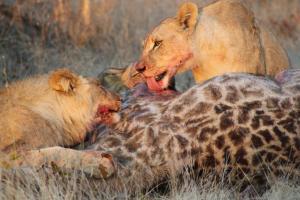
At a kill site
8. With canned hunting being a popular ‘recreational activity’ for some misinformed people, how do we begin to fight this in country?
This is tougher question than most people would like to think. There are (believe it or not) arguments for canned hunting and of course many against. I have spoken to many prominent scientists who work in lion conservation who believe that canned hunting, however distasteful, is reducing the demand for wild lions by the hunting industry and as such is serving a conservation benefit in that sense. To what extent this is true I really do not know. There are arguments that canned hunting is creating land use for wildlife as well as contributing to economic development in areas where it happens. It certainly is an economically important industry, there is no doubting that, and would its ban cause an economic problem, and should we care if it did? The argument that there is more land for wildlife is bogus to me as these animals are not being managed on a meta-population basis so they are nothing more, in my mind, to free-ranging zoos that add nothing to the conservation
of the species involved, be they impala or kudu , buffalo or what.
Obviously the lions are not able to free-range in these fenced reserves until they are ready to be shot or they will eat too much of the reserves
other species; and the conditions under which they are kept are often poor. The welfare complaints are there for sure. So basically, as with
everything, it is not a straight forward issue although I am sure most people blind themselves to realities because it is easier to just say no
than consider all aspects of something that is deemed so unpleasant. My personal belief is that nothing justifies the practice and it should be got
rid of, and we will deal with any negatives that such action may cause, but there will be negatives. So, it will be the means of its closure that are
going to be important to ensure we reduce the potentially negative impacts.
How do we get rid of it? Well let’s face it, despite worldwide condemnation and the actions of pressure groups towards abolition, nothing really has changed. It’s only going to work if the governments decide that the benefits to the nation of not having canned hunting are greater than having it. We are working with Zimbabwe authorities as part of a task force on regulations that is at the final draft stage to ensure that canned hunting does not illegally continue in the country, nor that it might be legally introduced. But we have to consider the Zimbabwean authority’s motivation for this. It is probably that Zimbabwe wants to maintain its wild lion trophy hunting operations as well as photographic tourism and sees the move to ban canned hunting as a way to protect both. So even though we seem to have succeeded in getting rid of one horror, a principle aim for the wildlife authorities is to be able to support another in the shooting of wild lions; which are under huge pressure from hunting in the country. Again, nothing is as simple as it might seem. We are trying the same approach with the Zambian government, but they currently see canned hunting as a viable revenue stream for them and the first operator that intends to canned hunt has now been granted permits to import lions, including white ones (they gain a higher price to shoot them) and has established an operation in the country. There is another operator with lions in Zambia that we think (are pretty sure) is going the same route. And I am not sure tourists boycotting a country is the answer. Part of the reason Zambia is bringing in canned hunting is because tourism arrivals are down and they are looking for diversified revenue streams to make up the shortfalls.
So in short, I don’t know. I think if I did I would be one of the most lauded people in the world. I’ll let you know if I get any further, but for
now, we think we have success in Zimbabwe. And then we try and use the same methods to achieve results elsewhere.

Running, exercise, health, natural behaviour
9. In the program ‘Last of the Lions’ there is an extremely worrying message that the lions may go extinct. What are your thoughts on this?
The species will not likely go extinct, but we might have functional extinction in a short period of time, whereby the remaining populations are
non-viable in terms of evolutionary potential. In fact most sub-populations are already at this stage and are unlikely to recover unless they are able to genetically interact with others. Again I would refer you to the attached white paper that covers a lot of this issue. I think the lion is
in real trouble, but we have time to save it, but only if ex-situ conservation measures are included alongside in-situ – lions need all the
help they can get; to rule out options that we are likely to need seems insane to me.
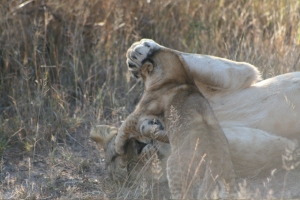
10. I believe that education is one of the main ways to help prevent people from participating in canned hunting and unethical forms of tourism. What other things can be done?
I’m not sure you are right there. Do you think the hunter who has booked a canned hunt does not know what he is getting? And chooses to do it anyway! Yes, there are examples where hunters are duped into believing they are shooting a wild lion when in fact it’s a canned hunt. Unless the people buying canned hunts are made social pariahs, and care about that, there will continue to be demand, and therefore supply, fully supported by government who is getting their cut either through tax revenues or through corrupt pay-off to individuals. You also need to define what is unethical. What I find ok others do not. What I find unethical others do not. As society we need to start by having a better process to debate these issues so that consensus can be achieved on what to accept and what not to. Do we have to come to terms that canned hunting will always be with us (its history dates back at least as far as the Pharaohs of Egypt) because enough people and governments want it? In which case are we better off pushing for better regulation and putting up with something that you or I and many others do not agree with? I would think, if asked, the vast majority of the world is against prostitution. Does it exist, has it always existed, will it always continue to exist? Yes. Is it more acceptable to me where it is regulated than where it is illegal? Yes. That has not changed my mind that the world is better off without prostitution, but whilst there is demand there will always be supply, legally or otherwise. How would regulations work for canned hunting such that you had the information about whether that cub made available to cuddle will eventually be shot so you can choose or choose not
to visit that location? I am not sure, but it surely cannot be beyond the whit of man to do this? There are also many tourism operations that are not beneficial to the environment or ethical in their dealings; how do we regulate that?
I hate this issue because I cannot fathom why someone would want to shoot an animal, but I do not have the answers of how to get rid of it (and clearly no-one else does either). And I also have to ask myself whether it is right for me to enforce my beliefs on this matter on other people when many of them clearly do not agree with my beliefs – no matter how much I wish they would.
Here is an article on canned hunting that people may find interesting, or maybe disconcerting:
http://lionalert.org/pages/issues%20canned%20vs%20wild%20hunting.html

11. Every now and then, we meet animals that have something special about them, something extra, which makes them extraordinary creatures. eg: Christian the Lion. Have you got a special lion? And can you share some of his/her story with me?
I’m often asked whether I have a favourite lion. My answer is honest; its whichever one is front of me at the time. Our program is not about
individuals, it’s about the species, so are there any I should pick out for special attention? No. But ask me privately and I will tell you that our
lioness Phyre in the Ngamo pride is a very special to me. She is a singular lion because of her character and at one point nearly died when she got sick as a cub. She was the first lion I raised so I feel a connection; even if at this point she clearly doesn’t. She is now the dominant female in our first release pride and I am expecting her to give birth to her first litter in a couple of weeks. The cub known as AT1 in the Ngamo release site; the first ever cub to be born in the program under natural conditions is also very special.
The pride’s story is available here – http://ngamo.wordpress.com/
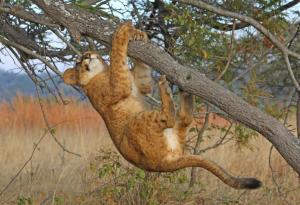
12. I have always had a special place in my heart for Lions, they are such a noble creature. However, with all of the threats that the lion faces, it’s now become known that lions are beginning to replace tigers, in the TCM wine. Lions are procured via the wildlife trade. Can you give me an insight into the reality of the wildlife trade of Lions?
To be honest I cannot speak authoritatively on this issue. There are serious concerns as you say that lions are replacing tigers in eastern
markets and lion trophies are in high demand and not always legally traded. I would not like to say more without having a better understanding of this particular aspect of lion conservation. We partner with another lion charity called Lion Aid (www.lionaid.org) that is more active in this area. I suggest taking a look at their web site; there are some interesting articles.
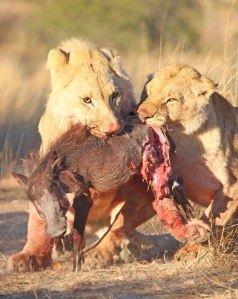
13. How difficult is it to avoid the canned hunting industry, and/or the corrupt elements that operate in the wildlife trade when selling on the lions?
Very. It’s a secretive industry that tries very hard to cover its tracks.
And there are huge amounts of money changing hands with government officials in the pockets of the operators. It’s a complete mess.
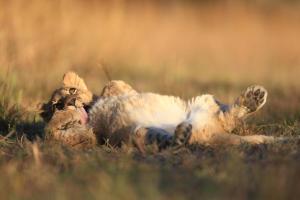
14. What is the time frame that you believe your first pride will be well and truly adjusted into the wild?
We believe that our Ngamo pride is already adjusted in their environment and the Dambwa pride release very recently is doing well also. We are seeking funding to move them to a larger area so that the Ngamo release site can be made available for the next group. Land is not the issue, funding (as ever) is the issue, but we strive every day to approach every potential source to get this done. As for the release into the wild of the cubs born to our released prides, the first cub is with us now, with 3 females likely to give birth over the next couple of months. Standard protocols for reintroduction means we are looking at the release into the wild in around 2.5 – 3 years. Then the question is how long it will take them to adjust to their new wild home.
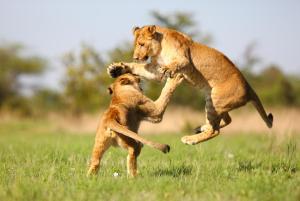
15. Part of the work that I do is to recommend ethical places of animal travel to tourists. As there will always be animals in captive environments, I ensure that places housing animals for tourism are caring for them correctly, at the correct standards, and are treated humanely. Can you guarantee to me that your facility meets all those standards?, and elaborate your reasons.
The best answer to this is to provide you with an independent report to the Zambia Wildlife Authority as part of the process of their decision making to permit the expansion of the program to Zambia . Attached here and named WWF Letter. Key points as follows:
“The housing and care of the lions was assessed by the Zimbabwe National Society for the Prevention of Cruelty to Animals and found to be excellent. The ZNSPCA further concluded that the lion breeding program was highly ethical and extremely well managed”
And
“An assessment was undertaken jointly by a team comprising an independent consultant biologist and two members of the Zimbabwe Parks & Wildlife Management Authority. The team reported favourably on this rather unique and specialised activity and their assessment was generally supportive of “Walk with Lions”.
.WWF SARPO has no objections to operations of this nature, provided the principles and practices as developed and implemented by Antelope Park are adhered to.”
(from the report compiled by Dr. R.D. Taylor, Conservation Programme Director for the WWF Southern African Regional Programme Office (SARPO) 10th January 2005).
In addition, regular inspections are conducted by the Zimbabwe Parks & Wildlife Management Authority and the Zambia Wildlife Authority, and other relevant government agencies, to ensure standards are maintained. Antelope Park is a member of PAAZAB, the Pan-African Association of Zoos & Aquaria, which provides an ethical code to work by in the treatment of their animals. In addition, the task force we are working with on dealing with canned hunting in Zimbabwe also includes many regulations on the proper management of captive lion populations. We will make this available once the draft has been confirmed as final by the task force provided we are given permission
to do so by the wildlife authority.

